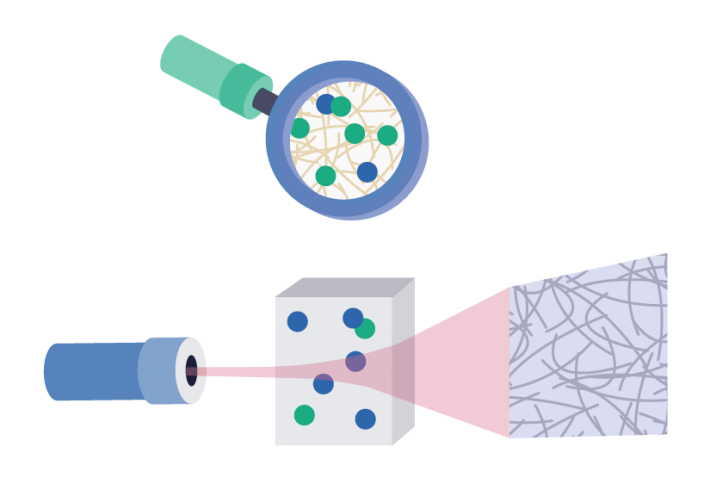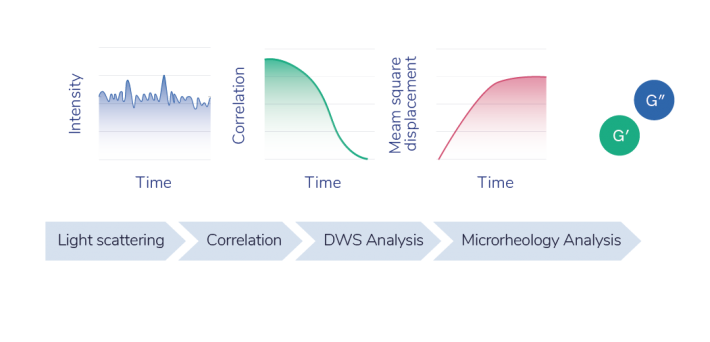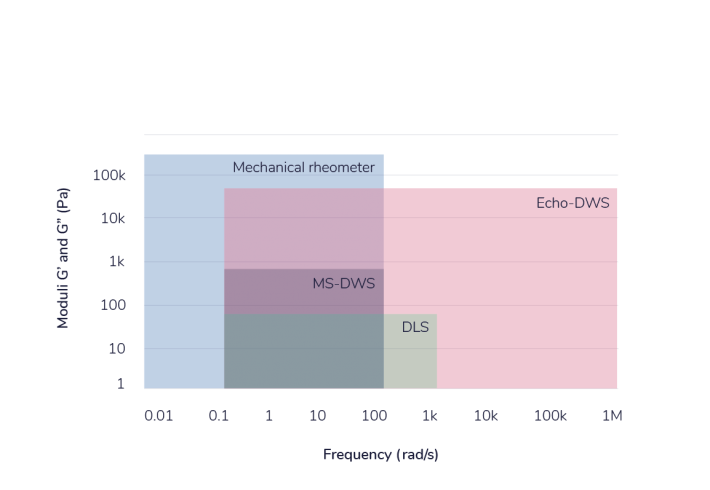The DWS RheoLab is an optical rheometer. It provides access to the sample's viscoelastic properties over an unmatched frequency range and enables the study of textures and microstructures while requiring only small sample volumes. Since the measurements are contact-free and non-destructive, the use of a tightly sealed sample cell allows studies of stability or shelf-life over long periods for highly viscoelastic and fragile microstructures. Based on the powerful DWS Microrheology technique, the RheoLab is ideally suited for a wide range of viscoelastic samples, including:
- polymers
- microgels
- protein solutions
- emulsions
- particle suspensions
- dairy
- cosmetic products
Videos
Files
| Attachment | Size |
|---|---|
| 2.15 MB | |
| 199.22 KB |
News, events, promotions, webinars
Microrheology is a rheological method that uses the Brownian motion of tracer particles embedded in the sample. As the viscoelastic properties of the surrounding environment influence the particle’s movement, microrheology can extract the viscoelastic properties without applying an external force. The RheoLab employs the DWS technology to extract the particle’s motion. DWS has an unmatched sensitivity that goes far beyond particle tracking, DLS or camera-based microrheology and can also measure a much larger range of sample viscosity.
DWS is an advanced light scattering technology used to measure the Brownian motion of tracer particles embedded in the sample. Similar to DLS, DWS analyzes the temporal intensity-fluctuations of light scattered by the particles. The statistics of these fluctuations are reflected in the measured correlation function from which the mean square displacement of the tracer particles can be calculated. DWS analyzes, in contrast to DLS, multiply scattered light. Each scattering event enhances the sensitivity, which makes DWS the most suitable technique for microrheology.
Most soft materials show viscoelastic behavior, so their mechanical properties lie between that of a purely elastic solid and that of a viscous liquid. DWS microrheology can quantify both the viscous-like and the elastic-like properties of a material over a large range of time scales; which makes it a most valuable tool for understanding the microstructure and relaxation times of many soft materials.
DWS RheoLab harnesses the patented Echo technique that allows rapid measurements of slowly relaxing samples equivalent to ordinary multi-speckle DWS (MS-DWS). The Echo-DWS technique also enables the measurement of high frequencies due to the fast detectors which give access to an unmatched frequency range, much larger than MS-DWS. Since Echo-DWS has a significantly higher tracer motion sensitivity than MS-DWS and DLS, it also allows the measurement of large moduli in samples such as firm gels and concentrated polymer solutions.
Technical Features
- Fully automated DWS Microrheology
- Applicable to all homogeneous transparent or opaque samples
- Fluid with a large range of viscosities from 0.1 mPa∙s to 1000 Pa∙s can be measured
- Storage and loss moduli G'(ω), G''(ω) in a frequency spectrum 0.1 Hz to 1 MHz (0.1Hz to10MHz with pseudo cross-correlation upgrade)
- Elasticity range from 1 Pa to 50 kPa
- Computes the mean square displacement (MSD) of particles
- Contact-free. No mechanical force applied to the sample: ideal for stability or shelf life studies
- Monitors time-dependent processes
- Regulated sample temperature from 4°C to 90°C*
- Temperature stability < 0.02°C*
- Compact and robust design
- Several cuvette sizes available
- Sample quantity down to 150 μl (for 1 mm thick sample cell)
- Several options available
- Particle sizing at high concentrations
- Online support forum for all customers
Technology | Diffusing Wave Spectroscopy with Echo Technology (EU Patent) |
Scattering geometry | Transmission (backscattering optional) |
Viscosity range | 0.1 m Pa · s to 1000 Pa · s * |
Storage (G) & loss (G) moduli | 1 Pa to 50 kPa * |
Frequency range | 0.5 rad/s to 105 rad/s (106 rad/s with extended frequency upgrade) |
Particle sizing** (radius) | 0.1 to 1 µm * (accuracy of ±5% in the turbid range) |
Cuvette sizes | 1 x 10 mm, 2 x 10 mm, 5 x 10 mm, 10 x 10 mm |
Sample volume | 150 µL to 1.5 mL, depending on cuvette used |
Temperature range | 4 to 100 °C (optional: 4 to 180 °C) with stability better than ±0.02 °C *** |
Laser class | 1 |
Laser | 685 nm with 45 mW |
Detector | High sensitive APD, QE > 65% |
Detection | Single mode fiber with integrated optics |
Correlator | Two channel multiple tau, 12.5 ns to 1 h |
Software | Including microrheological analysis |
Laboratory requirements | < 60 % relative humidity and T = 17 to 26 °C |
Size | 38 x 31 x 24 cm |
Weight | Approx. 14 kg |
* The maximum range is sample dependent.
** Requires backscattering mode.
*** A climate controlled room at or below 23 °C required to meet these specifications, for temperatures below the dew point a dry air source is required. (optional: 4 to 180 °C)




